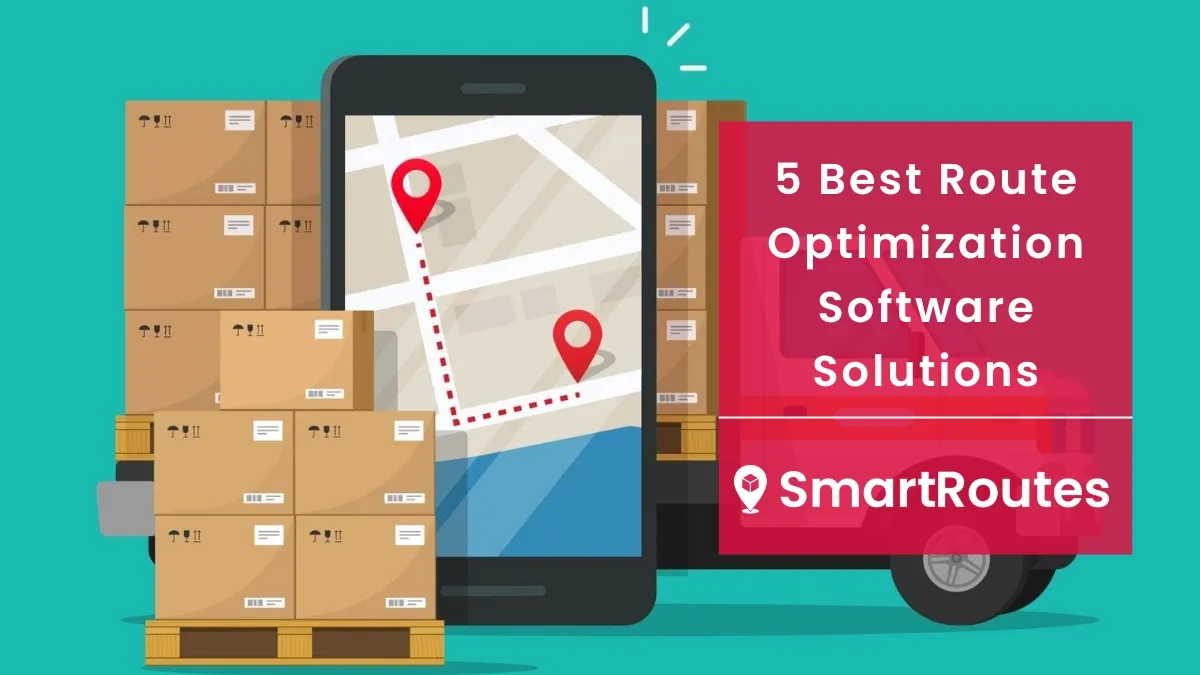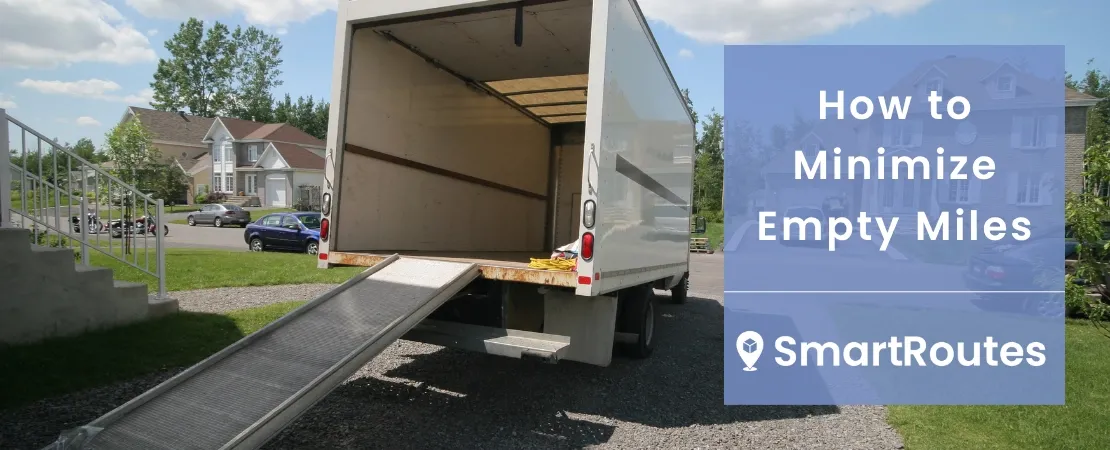Empty miles, also known as 'deadhead miles,' are a significant challenge in the world of logistics. These miles represent a costly and inefficient aspect of the industry. In this blog post, we will delve into what empty miles are, how they are calculated, the costs associated with them, and most importantly, how to avoid them. We'll also explore the benefits of reducing empty miles and how route optimization software can play a crucial role in optimizing your logistics operations!
What are Empty Miles in Logistics?
Empty miles (also known as 'deadhead miles' or 'unloaded miles') are a critical concept in the logistics and last-mile delivery industries. These miles represent the distance traveled by delivery vehicles when they do not contain any freight. One common scenario where empty miles occur is during the return leg of a delivery journey. After successfully delivering their shipments to their destinations, trucks often have to make the journey back to their home base or the next pick-up location without any cargo on board. These return trips with empty or partially empty vehicles cover a significant portion of the total miles covered by logistics companies.
In 2021, more than a fifth of the distance driven by European cargo trucks consisted of empty miles (source: CNBC). In other words, for every five miles driven, one mile was covered with empty trucks! This wasteful practice has a negative economic impact and environmental consequences. These miles reflect a lack of operational efficiency. They represent a missed opportunity to optimize logistics operations, as resources are not fully utilized.
SmartRoutes Route Planning Software
Streamline your entire delivery process, all from one platform

How Do You Calculate Empty Miles?
Calculating empty miles involves precisely determining the distance traveled by cargo trucks or vehicles without any freight or payload on board. One of the main methods for calculating empty miles is by using routing technology. GPS data and real-time tracking tools have revolutionized the way logistics companies approach this task. These technologies offer accurate and real-time information about the movements of vehicles, making it possible to identify and quantify empty miles with precision.
Once this data has been collected, the next step involves subtracting the loaded miles from the total miles traveled. This subtraction reveals the extent of empty miles within a specific journey or across a series of trips.
Cost of Empty Miles = (Total Miles - Distance traveled with freight) X (fuel + labour + vehicle maintenance + all other costs associated with the journey per mile)
The Cost of Empty Miles
The costs associated with empty miles are often underestimated. They can however have a huge effect on the efficiency and profitability of operations. Here are some of the key cost components associated with empty miles:
Fuel Costs: One of the most immediate and substantial (and probably most obvious!) costs of empty miles is fuel consumption. Vehicles traveling empty or partially loaded still burn fuel, but they do so without generating any revenue. This fuel expense represents a direct hit to the company's operational budget. As the price of fuel continues to fluctuate, the impact of empty miles on fuel costs becomes even more pronounced.
Maintenance Expenses: Empty miles contribute to additional wear and tear on vehicles. Increased wear and tear may result in more frequent maintenance and repairs. Maintenance costs, including parts replacement and labor, can quickly escalate for vehicles that regularly cover empty miles.
Reduced Profit Margins: Empty miles are, essentially, unproductive miles. When trucks are on the road without cargo, they are not generating revenue for the company. This lack of revenue directly affects profit margins. Moreover, it reduces the efficiency of logistics operations, as resources such as time, labor, and fuel are not being utilized optimally.
Environmental Impact: While not a direct financial cost, empty miles also have environmental consequences. Increased fuel consumption during empty trips leads to higher carbon emissions, contributing to the company's carbon footprint.
How to Avoid Empty Miles
By implementing the following strategies, logistics companies can optimize their operations and reduce the financial and environmental costs associated with empty miles:
Less-Than-Truckload (LTL):
Less-than-truckload (LTL) is a powerful strategy to minimize empty miles by consolidating multiple smaller shipments into a single truckload. LTL allows logistics companies to maximize the utilization of cargo space. Instead of traveling with empty or largely empty vehicles, businesses can fill their part-loaded trucks with shipments from multiple customers, reducing the occurrence of empty return trips.
LTL shipments result in cost savings, as they optimize the allocation of resources and reduce fuel consumption. By efficiently utilizing cargo space and minimizing empty miles, logistics companies can improve their bottom line.
Use Route Optimization Software:
Leveraging advanced route optimization software can be instrumental in avoiding empty miles. Route optimization software uses advanced algorithms to create the most efficient delivery routes. It factors in variables like traffic conditions, delivery windows, and cargo capacity, ensuring that trucks take the most efficient paths, and minimizing empty miles.

These systems also provide real-time monitoring and route adjustments, allowing logistics professionals to respond to traffic delays or changing circumstances, reducing the risk of empty miles. Route optimization software assists in load planning, optimizing the allocation of cargo to vehicles. It helps ensure that trucks are consistently filled with cargo, minimizing the likelihood of empty return trips.
Search for Backhaul/Reverse Logistics Opportunities:
Actively seeking backhaul or reverse logistics opportunities is another strategy to minimize empty miles. Logistics companies can establish partnerships or agreements with other businesses or suppliers to find cargo for the return journey after making deliveries. This approach helps fill empty vehicles on the way back, reducing empty miles. You can also consider offering return pick-up services in regions where your drivers are delivering goods, further optimizing the use of the delivery vehicles.
Multi-Stop Routing:
Multi-stop routing, or multi-drop deliveries, involves making multiple deliveries along a single route instead of a one-way journey with a single destination. This strategy can significantly reduce empty miles by maximizing cargo space. It ensures that vehicles are consistently filled with cargo. By making multiple deliveries along a route, logistics companies can minimize the occurrence of empty return trips, improving overall efficiency.
The Benefits of Reducing Empty Miles
Reducing empty miles in logistics operations offers a host of advantages. These benefits contribute to a more sustainable, efficient, and profitable logistics industry, benefiting both businesses and the environment.
1. Cost Savings:
Reducing empty miles translates directly into cost savings for logistics companies. Empty miles are essentially fuel wasted without generating revenue. By minimizing empty trips, logistics companies can significantly reduce their fuel consumption, which is often one of the most substantial operational expenses.
Extended empty miles contributes to additional wear and tear on vehicles. This increased wear and tear results in more frequent maintenance and repairs, driving up maintenance expenses. By minimizing empty miles, logistics companies can extend the lifespan of their vehicles and reduce maintenance costs.
Fewer empty miles mean more efficient resource allocation. Resources such as labour, vehicle fleets, and time are used more effectively, resulting in cost-efficient operations.
2. Environmental Impact:
Empty miles contribute to unnecessary fuel consumption and consequently, increased carbon emissions. By minimizing empty miles, logistics companies can reduce their carbon footprint, contributing to environmental sustainability and aligning with growing societal and regulatory concerns about climate change.
3. Improved Efficiency:
With fewer empty miles, logistics operations become more streamlined and efficient. Vehicles are consistently engaged in revenue-generating activities, such as transporting cargo, rather than traveling empty.
Eliminating empty miles means quicker deliveries. Customers receive their goods more promptly, which can lead to increased customer satisfaction and loyalty.
Reduced empty miles mean that resources like drivers and vehicles are more effectively utilized. This optimization leads to improved operational efficiency and reduced idle time.

4. Increased Profitability:
Minimizing empty miles means that trucks are consistently loaded with cargo, maximizing revenue for each trip. This increased revenue directly contributes to improved profitability.
A more efficient operation with lower expenses and increased revenue leads to improved profit margins. Companies that effectively reduce empty miles can allocate resources to other strategic investments or growth opportunities.
SmartRoutes Can Help Reduce Your Empty Miles
SmartRoutes reduces empty miles by ensuring that trucks are consistently loaded with cargo, leaving no room for inefficient, unprofitable trips. The platform strategically allocates cargo to available trucks, considering factors like size, weight, and destination. This intelligent load planning minimizes the risk of empty return trips.
We understand that adopting new technology is a significant decision for your logistics business. To help you experience the benefits of SmartRoutes firsthand, we are pleased to offer you a 7-day free trial. During this trial period, you will have full access to SmartRoutes' powerful features and see how we can make a positive impact on your logistics operations.
FAQ
1. What are the main causes of empty miles in logistics?
Empty miles can result from various factors, including inefficient routing, lack of backhaul opportunities, inaccurate demand forecasting, and poor load planning. Identifying these causes is crucial to addressing the issue effectively.
2. How can I calculate the empty miles in my logistics operations?
Calculating empty miles involves tracking the distance traveled without cargo on board. You can use GPS data and route tracking software to determine empty miles. Subtracting loaded miles from total miles traveled provides the empty miles figure.
3. How can companies successfully reduce empty miles?
Many companies have successfully reduced empty miles by implementing strategies such as embracing LTL shipments, utilizing route optimization software, forming backhaul partnerships, and adopting dynamic routing technologies.
4. Is SmartRoutes suitable for small logistics companies, or is it better suited for larger operations?
SmartRoutes is designed to benefit logistics companies and teams of all sizes. Whether you have a small or large fleet, SmartRoutes' advanced routing technology can be tailored to your specific needs and help reduce empty miles effectively.
If you enjoyed this blog, you might also be interested in:



